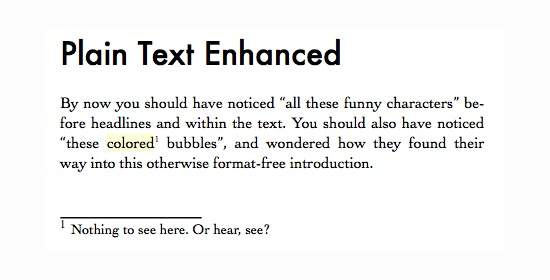What follows is a small code sample from one of the default styles we will ship in 1.1 – we call it Novel Cochin, as it’s a classic book layout, complete with page spread based on the canons of page construction.
Yes, we’re like that.
This is code, so it’s boring to look at, but if you’re even remotely interested in how things will work with regards to PDF/RTF export, I urge you to check out these few lines of monospaced dullness…
Ok, here we go.
defaults {
font-family: "Cochin"
font-size: 11pt
line-height: 14pt
text-alignment: justified
hyphenation: yes
}
Simple, right? Note that we have set hyphenation to “yes”, since we’re aiming for a classic look and thus also have set text-alignment to “justified”.
heading-all {
font-family: "Futura"
keep-with-following: true
text-alignment: left
hyphenation: no
}
Here, we define some basic values for all headings. We switch the font, the justification, and turn off hyphenation. We also ask all headlines to stick to the next paragraph or whatever follows, so that no headline will be left behind.
heading-2 {
font-size: 22pt
margin-top: 28pt
margin-bottom: 14pt
}
For heading 2, we define a specific font size and individual margins. We could also specify font- and background colors, a dedicated font style (such as “Condensed Medium Oblique”), and even make the Markdown tags visible and outdented to the left.
Or indented. To the right.
paragraph {
first-line-indent: 10pt
}
Since we’re classy, we want every paragraph to begin with a small indentation.
heading-all + paragraph {
first-line-indent: 0pt
}
And since we know what we’re doing, we also don’t want to indent paragraphs that immediately follow any heading. Never. Never ever.
Now, as you can see, this is all rather straight-forward up to this point, and I will leave it at that for now. If you know your way around CSS, Ulysses Style Sheets will be a no-brainer, really.
If you have never touched anything remotely like that, the built-in styles will be great starting point to modify, experiment, and come up with your own styles.
The next post will cover some of the more advanced options, such as variables and mixing and… I’m getting carried away, sorry.
